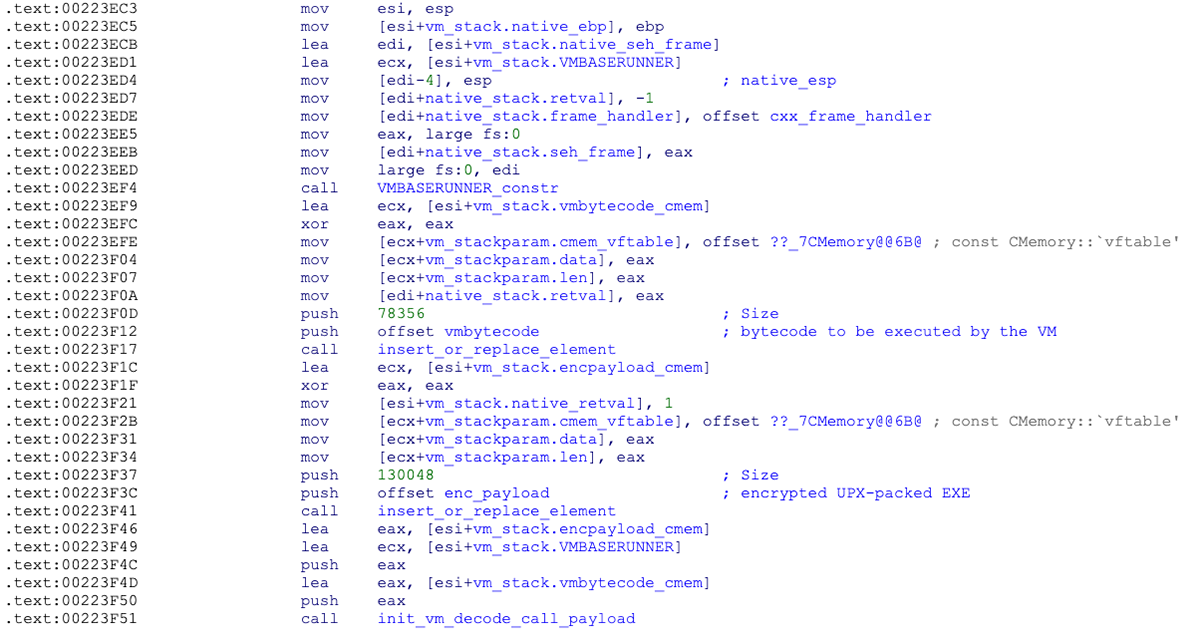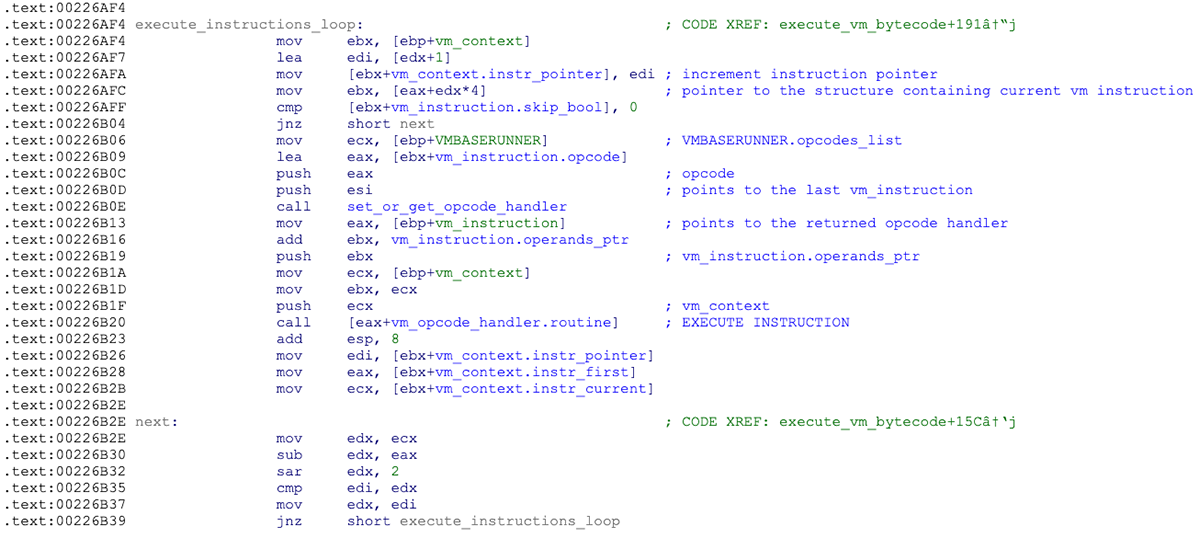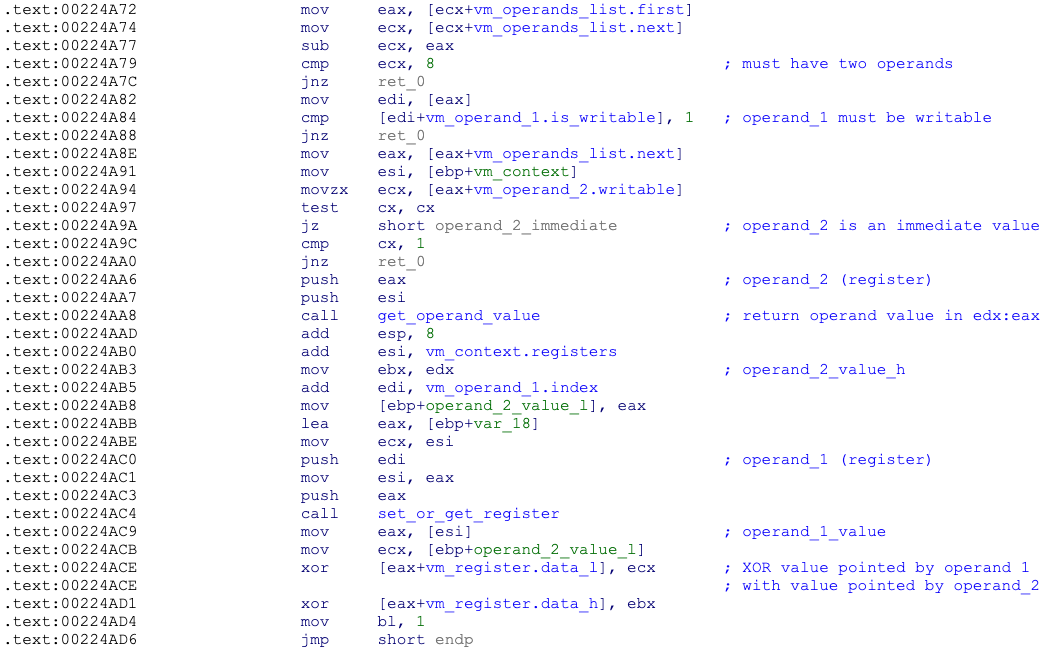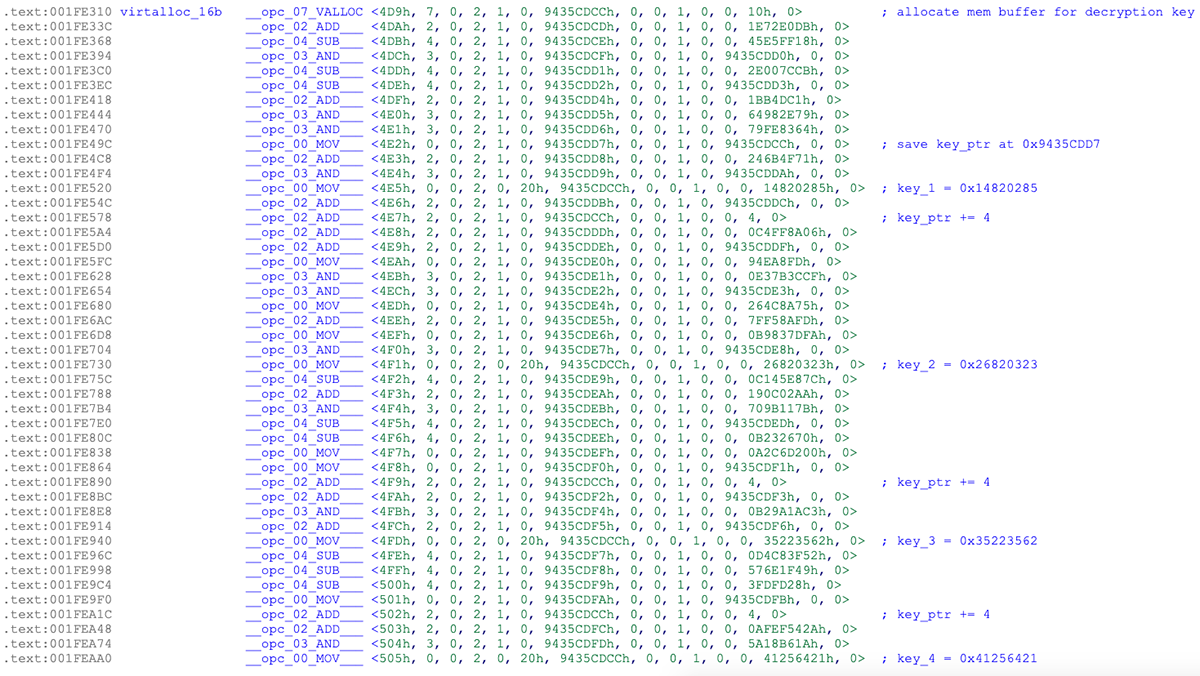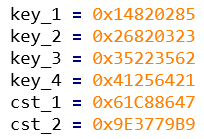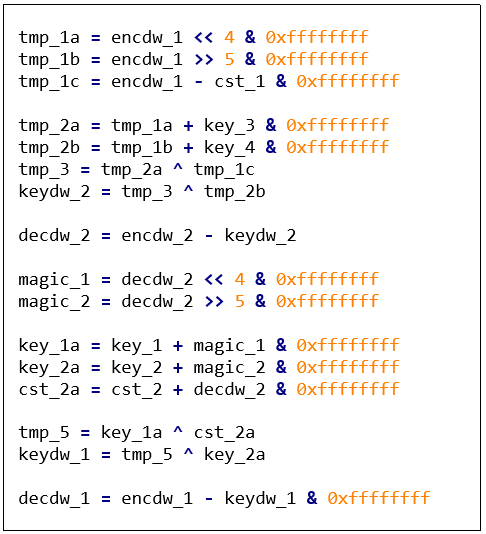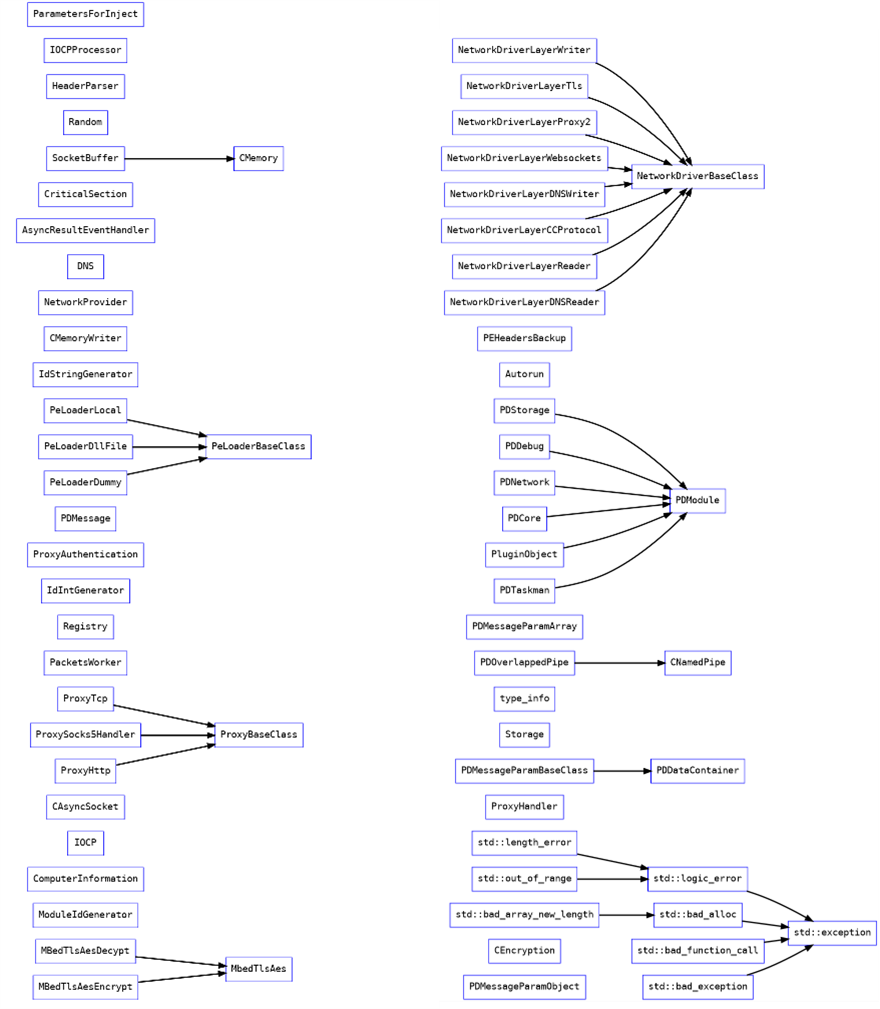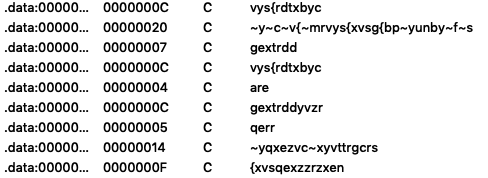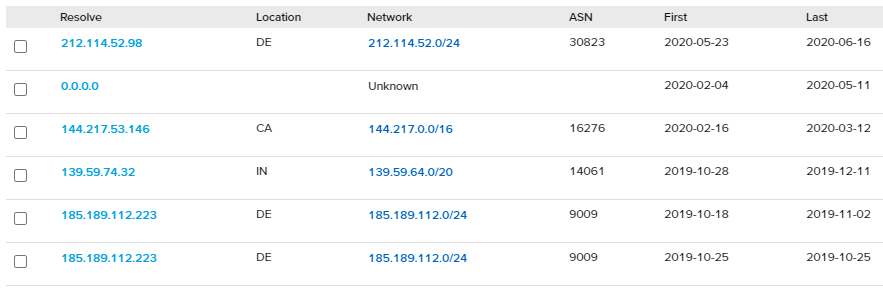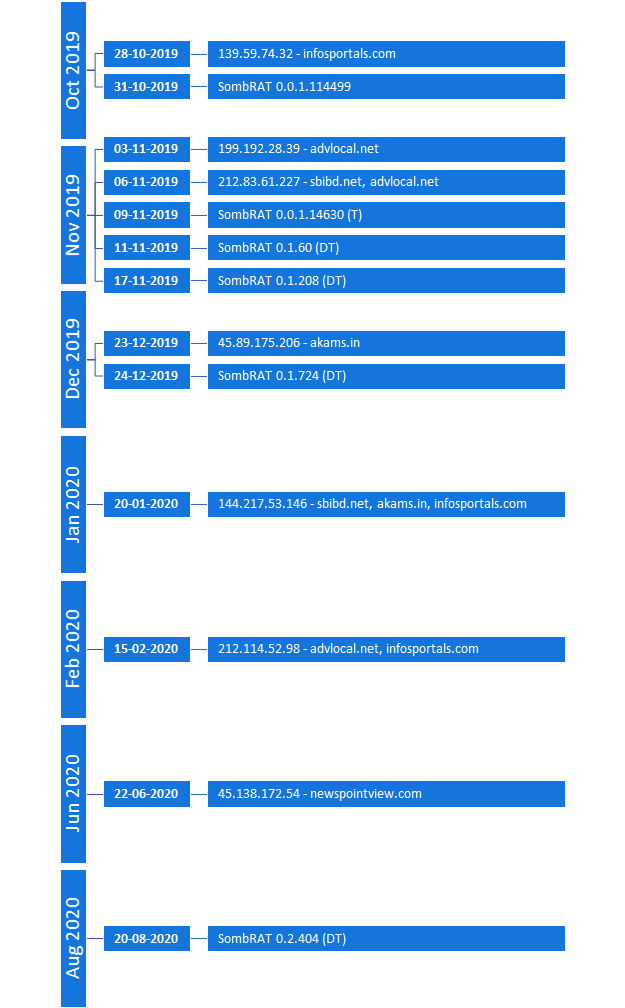The CostaRicto Campaign: Cyber-Espionage Outsourced
With the undeniable success of Ransomware-as-a-Service (RaaS), the cybercriminal market has expanded its portfolio to add dedicated phishing and espionage campaigns to the list of illicit services on offer…
During the past six months, the BlackBerry Research and Intelligence team have been monitoring a cyber-espionage campaign that is targeting disparate victims around the globe. The campaign, dubbed CostaRicto by BlackBerry, appears to be operated by “hackers-for-hire”, a group of APT mercenaries who possess bespoke malware tooling and complex VPN proxy and SSH tunnelling capabilities.
Mercenary groups offering APT-style attacks are becoming more and more popular. Their tactics, techniques, and procedures (TTPs) often resemble highly sophisticated state-sponsored campaigns, but the profiles and geography of their victims are far too diverse to be aligned with a single bad actor’s interests.
Although in theory the customers of a mercenary APT might include anyone who can afford it, the more sophisticated actors will naturally choose to work with patrons of the highest profile – be it large organizations, influential individuals, or even governments. Having a lot at stake, the cybercriminals must choose very carefully when selecting their commissions to avoid the risk of being exposed.
Outsourcing an espionage campaign, or part of it, to a mercenary group might be very compelling, especially to businesses and individuals who seek intelligence on their competition yet may not have the required tooling, infrastructure and experience to conduct an attack themselves. But even notorious adversaries experienced in cyber-espionage can benefit from adding a layer of indirection to their attacks. By using a mercenary as their proxy, the real attacker can better protect their identity and thwart attempts at attribution.
Key Findings:
- CostaRicto targets are scattered across different countries in Europe, Americas, Asia, Australia and Africa, but the biggest concentration appears to be in South Asia (especially India, Bangladesh and Singapore), suggesting that the threat actor could be based in that region, but working on a wide range of commissions from diverse clients.
- The command-and-control (C2) servers are managed via Tor and/or through a layer of proxies; a complex network of SSH tunnels are also established in the victim’s environment. These practices reveal better-than-average operation security.
- The backdoor used as a foothold is a new strain of never-before-seen malware – a custom-built tool with a suggestive project name, well-structured code, and detailed versioning system. The earliest timestamps are from October 2019, and based on the version numbers, the project appears to be in the debug testing phase. It’s not clear as of now if it’s something that the threat actors developed in-house or obtained for exclusive use as part of beta testing from another entity.
- The timestamps of payload stagers go back to 2017, which might suggest the operation itself has been going on for a while, but used to deliver a different payload. It’s not impossible, though, that the stagers are simply being reused without recompilation (i.e.: by changing the C2 URLs via binary editing).
- The backdoor project is called Sombra, which is a reference to an Overwatch game persona – an agent of the antagonist organization, who specializes in espionage and intelligence assessment and is characterized by stealth, infiltration and hacking skills.
- Some of the domain names hardcoded in the backdoor binaries seem to spoof legitimate domains (e.g.: the malicious domain sbibd[.]net spoofing a legitimate domain of the State Bank of India Bangladesh, sbibd.com). However, victims affected by these backdoors are unrelated, suggesting reuse of existing infrastructure which served another purpose.
- One of the IP addresses which the backdoor domains were registered to overlaps with an earlier phishing campaign attributed to APT28 (i.e.: according to RiskIQ data, the SombRAT domain akams[.]in was at the time of attack registered to the same IP address as the phishing domain mail.kub-gas[.]com). However, BlackBerry researchers believe that a direct link between CostaRicto and APT28 is highly unlikely. It might be that the IP overlap is coincidental, or – just as plausible – that the earlier phishing campaigns have been outsourced to the mercenary on behalf of the actual threat actor.
Targeting
Unlike most of the state-sponsored APT actors, the CostaRicto adversary seems to be indiscriminate when it comes to the victims' geography. Their targets are located in numerous countries across the globe with just a slight concentration in the South-Asian region:
- India
- Bangladesh
- Singapore
- China
- U.S.
- Bahamas
- Australia
- Mozambique
- France
- Netherlands
- Austria
- Portugal
- Czechia
The victims’ profiles are diverse across several verticals, with a large portion being financial institutions.
Delivery
After gaining access to the victim’s environment (presumably by using stolen credentials, either obtained via phishing, or bought on the dark web), the attacker sets up remote tunnelling using a SSH tool. The tool is configured to redirect traffic from a malicious domain to a proxy that is listening on a local port. The tunnel is authenticated using the attacker’s private key.
In order to pull down the backdoor, a payload stager, either HTTP or reverse-DNS, is executed with the use of a scheduled task.
The backdoor comes either wrapped up in a PowerSploit reflective loader, or in the form of a custom-built dropper that uses a simple virtual machine (VM) mechanism to decode and inject the payload.
Toolset
- SombRAT: A custom backdoor (with both x86 and x64 versions)
- CostaBricks: A custom VM-based payload loader (seen only with x86 SombRAT payloads so far)
- PowerSploit’s reflective PE injection module (seen with x64 SombRAT payloads)
- HTTP and reverse-DNS payload stagers
- nmap: Port scanner
- PsExec
PS1 Loader (x64)
The 64-bit backdoor is deployed in a fairly standard way. It is distributed as a set of scripts and encrypted files and utilizes a PowerShell loader based on the Invoke-ReflectivePEInjection PowerSploit module to decode and inject the final payload DLL into memory:
File Name
|
Function
|
autorun.bat
|
Obfuscated batch script that sets PowerShell execution policy to unrestricted and executes autorun.ps1
|
autorun.ps1
|
Obfuscated PowerShell script that decodes and executes another PowerShell loader stored in ntuser.c file
|
ntuser.a
|
XOR key used to decode the PowerShell loader and payload binary
|
ntuser.b
|
XOR encoded payload binary
|
ntuser.c
|
XOR encoded Invoke-ReflectivePEInjection module, modified to add payload decryption routine
|
CostaBricks Loader (x86)
The loader used with 32-bit backdoors is more technically compelling. It implements a simple custom-built virtual machine mechanism that will execute an embedded bytecode to decode and inject the payload into memory.
This attempt at obfuscation, although not new, is rather uncommon in relation to targeted attacks. Code virtualization has been most prevalent in commercial software protectors which use much more advanced solutions; simpler virtual machines are sometimes also featured in off-the-shelf malicious packers used by widespread financial crimeware. This particular implementation, however, is unique (there are just a handful of samples in the public domain) and seems to be used only with SombRAT payloads – which makes us believe it is a custom-built tool that is private to the attackers.
To further confuse anti-malware solutions, the loader contains the entire unobfuscated code of a legitimate open source application called Blink (https://github.com/crosire/blink), which never gets executed:
Figure 1: Strings belonging to Blink code
There is also an unused zlib decompression routine that seems to be leftover code from an older version of the loader.
The compilation timestamps suggest that both the loader and the embedded payload are compiled at the same time (with only a few seconds difference).
One of the loaders had the following PDB path, suggesting that the internal name of the project is CostaRicto/ CostaBricks:
Figure 2: PDB path from one of the x86 loader samples
Virtual Machine Internals
The virtual machine mechanism is implemented with the usage of C++ objects and classes. There are 20 different VM instructions, each having between zero and three operands. A pointer to the bytecode to execute is passed as a parameter to the VM initialization routine:
Figure 3: Initialization of the virtual machine
A VM instance is initialized by setting its context structure, which contains the instruction pointer, zero flag, instructions list and pointer to the registers:
Offset
|
Field
|
Description
|
0x00
|
Instruction pointer
|
Index of the bytecode instruction to execute
|
0x04
|
Zero flag
|
Used for conditional jumps
|
0x08
|
Instructions_list.first
|
Points to the first instruction in the list
|
0x0C
|
Instructions_list.current
|
Points to the current instruction in the list
|
0x10
|
Instructions_list.next
|
Points to the next instruction in the list
|
0x14
|
Registers pointer
|
Points to the list of registers
|
0x18
|
Registers count
|
Incremented when new register is allocated
|
Instructions and Operands
Instructions, operands, and opcode handlers are implemented as doubly linked lists. Each VM instruction has its own index and contains information such as the opcode number, flags, operands count, and the operands:
Figure 4: An example of VM instruction format for the SUB opcode
The operands can either be immediate values or "registers". Dynamically allocated “registers” are small memory regions organized in the form of dictionary objects in doubly linked list. Each register has its own unique index that can store up to 8 bytes of data (including pointers to larger memory buffers) and can be either read or written to.
If the operand metadata specifies the index value, the operand is a "register"; otherwise the operand contains an immediate value. The value (either immediate or pointed to by a "register") is an integer: qword by default, but different lengths (byte, word or double-word) can be specified in the metadata:
Offset
|
Field
|
Notes
|
0x00
|
Instruction index
|
Consecutive numbers starting with 0
|
0x04
|
Opcode
|
0 – 0x13 (19.)
|
0x06
|
Skip bool
|
If set, then the instruction will be ignored
|
0x08
|
Operands count
|
0 – 3
|
0x0C
|
Operand type
|
read (0) or write (1)
|
0x0E
|
Operand flag
|
Specifies length: 0x10 = byte, 0x20 = word, 0x40 = dword
|
0x10
|
Operand register index
|
Consecutive numbers starting with 0x9435C739
|
0x14
|
Operand value
|
Immediate value (if operand is not a register)
|
0x1C
|
Operand 2
|
Optional
|
0x2C
|
Operand 3
|
Optional
|
Opcodes
Each opcode has its own handler routine, which is executed in the main VM loop:
Figure 5: Loop processing VM instructions
The handler routine will check to see if the number and types of operands are valid, read operand values from VM “registers”, perform a specific action (arithmetic/byte operation, comparison, jump, API call), and save results to a destination “register”:
Figure 6: XOR opcode handler routine
Opcode (hex)
|
Operands
|
Instruction
|
Description
|
0x00
|
dst, src
|
mov
|
Move from src (either immediate value or pointer/register) to register at dst. If no operands, this acts as a NOP instruction, used mostly as a label to jump to
|
0x01
|
dst, src
|
xor
|
Exclusive or dst with src, result pointed by dst
|
0x02
|
dst, src
|
add
|
Add src to dst, result pointed by dst
|
0x03
|
dst, src
|
and
|
And dst with src, result pointed by dst
|
0x04
|
dst, src
|
sub
|
Subtract src from dst, result pointed by dst
|
0x05
|
addr
|
call
|
Call address in operand 1 (can be immediate value or register)
|
0x06
|
-
|
ret
|
Return 1
|
0x07
|
mem_ptr, size
|
virtual_alloc
|
Allocate memory (call VirtualAlloc), size in operand 2, pointer returned in operand 1 (register)
|
0x08
|
mem_ptr
|
virtual_free
|
Free memory (VirtualFree), pointer in operand 1 (register)
|
0x09
|
dst, src, size
|
memmove
|
Source pointed by operand 2, destination pointed by operand 1, size in operand 3
|
0x0A
|
dst, src
|
cmp
|
Compare value at dst (register) with src (immediate or register value), set zero flag in VM context structure
|
0x0B
|
dst, src
|
alldiv
|
Dividend in operand 1 register, divisor in operand 2 (immediate or register), result in operand 1 register
|
0x0C
|
dst
|
jnz
|
If zero flag not set, jump to location specified by operand
|
0x0D
|
dst
|
jz
|
If zero flag set, jump to location specified by operand
|
0x0E
|
dst
|
jmp
|
Unconditional jump; set instruction pointer to the value of operand
|
0x0F
|
dll_handle, dll_name
|
load_library
|
Call LoadLibraryA, pointer to library name in operand 2 (register), handle to loaded library in operand 1 (register)
|
0x10
|
dll_handle, proc_name, api_address
|
get_proc_addr
|
Call GetProcAddress, pointer to DLL handle in operand 1, pointer to process name in operand 2, API address returned in operand 3 (all operands are registers)
|
0x11
|
-
|
exit_proc
|
Call ExitProcess(0)
|
0x12
|
dst, src
|
shr
|
Shift right (divide dst by src)
|
0x13
|
dst, src
|
shl
|
Shift left (multiply dst by src)
|
The Bytecode
All of the x86 loaders BlackBerry has seen thus far embed the exact same bytecode that is 1800 (0x708) lines long. Most of these 1800 instructions are superfluous (i.e.: have no influence on the code functionality) and were inserted there for obfuscation only.
The purpose of the bytecode is to decrypt the embedded payload, load it into memory reflectively and execute it:
Figure 7: A fragment of VM bytecode - setting the decryption key
The payload decryption routine uses a custom symmetric algorithm based on arithmetic and byte-shift instructions – a combination of SHL/SHR/SUB/ADD/XOR – with hardcoded keys.
These constant values are used in all x86 SombRAT droppers we’ve seen so far:
Figure 8: Payload decoding algorithm
SombRAT Backdoor
The backdoor delivered by the above-mentioned loaders is a C++ compiled executable developed with heavy usage of objects, classes, and interfaces. It has a plugin architecture and basic functionality of a foothold RAT that is mainly used to download and execute other malicious payloads – either as its own plugins or standalone binaries. It can also perform other simple actions, like collecting system information, listing and killing processes, and uploading files to the C2.
Features:
- Communication over DNS tunnel with a hardcoded domain name and DGA-generated subdomain
- C2 traffic encrypted with RSA-2048
- Custom AES-encrypted storage format used to store configuration, plugins, and harvested data
- Unique version number for each sample
Figure 9: Backdoor classes hierarchy
According to a PDB path found in the 64-bit specimens, the project was originally called Sombra – possibly in reference to the Overwatch game character:
Figure 10: PDB path from 64-bit backdoor with project name ‘Sombra’
In the Overwatch game world, Sombra is an agent of an antagonist organization called Talon. She is skilled in computer hacking and cryptography and specializes in espionage and intelligence assessment:
“One of the world's most notorious hackers, Sombra uses information to manipulate those in power.
Sombra's skills include computer hacking and cryptography; these are activities she greatly enjoys, to the point where the desire to get past locks and solving mysteries is ingrained in her personality. She is a known associate of Reaper, specializing in espionage and intelligence assessment.
Stealth and debilitating attacks make Sombra a powerful infiltrator. Her hacking can disrupt her enemies, ensuring they're easier to take out, while her EMP provides the upper hand against multiple foes at once. Sombra’s ability to Translocate and camouflage herself makes her a hard target to pin down.”1
Embedded in each sample is a hardcoded version number, with the following versions observed thus far:
Version
|
Compilation timestamp
|
Architecture
|
0.0.1.114499
|
31-10-2019 21:22:39 UTC
|
x86
|
0.0.1.14630 (T)
|
09-11-2019 21:53:44 UTC
|
x86
|
0.1.60 (DT)
|
11-11-2019 14:55:45 UTC
|
x86
|
0.1.208 (DT)
|
17-11-2019 20:58:25 UTC
|
x86
|
0.1.724 (DT)
|
24-12-2019 10:33:41 UTC
|
x64
|
0.2.404 (DT)
|
20-08-2020 01:36:50 UTC
|
x64
|
One of the backdoor samples (0.1.60 (DT)) was found to be hosted on http[://]159.65.31[.]84/svolcdst.exe.
Behaviour
Before entering the command processing loop, the backdoor will check to see if it’s running as a service, and will create a run-once mutex consisting of %HOSTNAME% with a postfix of “S”, “U”, or “SU”, depending on which privileges it was executed with.
The C2 domain name for the DNS communication is hardcoded and obfuscated using XOR. The backdoor will generate a subdomain using a custom domain generation algorithm (DGA) and try to send an initial beacon to the C2 via DNS tunneling:
Figure 11: Decoding the C2 domain name
The configuration, along with downloaded plugins and all harvested data are stored in a custom database format inside a single file under the %TEMP% directory. The file name is hardcoded and obfuscated with XOR. The storage file is encrypted with AES-256 using a hardcoded key and is decrypted each time the malware needs to read or write it and re-encrypted after new data is added:
Figure 12. Hardcoded AES key for storage encryption
Strings used as backdoor commands and in debugging messages sent to the C2 are encoded with a simple alphabet substitution. These are not decrypted by the backdoor on the victim’s side, and the key for decryption is not present in the binary. Most probably the backdoor client decrypts them locally:
Figure 13: Substitution-encoded strings
Command and Control (C2)
The C2 communication can either be performed via DNS tunnelling or TCP sockets. Traffic is SSL-encrypted and can bypass HTTP/SOCKS5 proxies. The C2 domain name is hardcoded in the binary and obfuscated with a single-byte XOR key which differs between samples. In order to establish communication, the malware first uses a DGA (Domain Generation Algorithm) to generate the subdomain to connect to. Depending on an internal boolean setting, one of the following URL formats is used:
- images%x.%s
- images%x.elmako.%s
where %s is the hardcoded domain name and %x contains 8 hexadecimal characters generated based on the result of the GetTickCount API:
If the connection is unsuccessful, the backdoor will try to generate and connect to several other URLs in the same domain, using the same algorithm but without the “images” prefix.
It seems that in most cases, the malware sends out data using DNS_TYPE_TEXT requests, while the attackers issue commands separately over the TCP channel with the IP address associated with the DGA-generated subdomain.
All the communication is compressed with zlib and encrypted with AES. Additionally, an embedded RSA public key is used to secure the AES key exchange:
Figure 14: RSA key used for C2 traffic encryption
Backdoor Commands
Both the x86 and x64 versions of the backdoor feature approximately 50 different commands organized into six groups, each group served by a different interface:
- Core
- Taskman
- Config
- Storage
- Debug
- Network
Command
|
Type
|
Description
|
networkdisconnected broadcast
|
Core
|
Broadcast “networkdisconnected” message
|
informationaccepted broadcast
|
Core
|
Save provided session ID to memory struct, broadcast “informationaccepted” message
|
networkconnected broadcast
|
Core
|
Broadcast session ID and system info
|
ping
|
Core
|
Send a "ping" to the C2 server
|
loadasdll
|
Core
|
Load additional DLL into memory
|
loadfromstorage
|
Core
|
Inject DLL into memory (from storage)
|
loadfromfile
|
Core
|
Inject DLL into memory (from disk)
|
loadfrommem
|
Core
|
Inject DLL into memory (from memory)
|
loadplugincomplete
|
Core
|
Execute a plugin that is already loaded
|
initializeandloadpluginby-
uniqid
|
Core
|
Load and execute a plugin; plugins are stored as zlib-compressed and AES encrypted PE files inside the storage and referred to by unique identifier
|
getinfo
|
Core
|
Obtain environment strings, computer name, username, OS version information, system time, etc.
|
restart
|
Core
|
Respawn using ShellExecuteW
|
shutdown
|
Core
|
Exit process
|
uninstall
|
Core
|
(unimplemented)
|
updatemyself
|
Core
|
Create backup of itself (with .old extension) and spawn new instance via CreateProcessW
|
pluginunload
|
Core
|
Unload and remove plugin from storage
|
getprocesslist
|
Taskman
|
Obtain a list of running processes
|
killprocessbypid
|
Taskman
|
Terminate a process by PID
|
killprocessbyname
|
Taskman
|
Terminate a process by name
|
get
|
Config
|
Read specified values from .config file in storage and send to the C2
|
set
|
Config
|
Set specific config fields and save to .config file in storage
|
del
|
Config
|
Delete specified config fields from .config file in storage
|
initdefaults
|
Config
|
Initialize config fields with default values and save to .config file in storage
|
clear
|
Config
|
Zero-out config fields and save to .config file in storage
|
save
|
Config
|
Save provided config values to .config file in storage
|
enum
|
Config
|
Read values from .config file in storage to memory
|
write
|
Storage
|
Encrypt and write data to storage file
|
create
|
Storage
|
Create new encrypted storage file
|
close
|
Storage
|
Encrypt and flush data to storage file
|
drop
|
Storage
|
Write supplied file content to storage file
|
delete
|
Storage
|
Delete file with specified ID from storage; enumerate files in storage
|
enum
|
Storage
|
Enumerate files in storage (name, written, size)
|
upload
|
Storage
|
Decrypt and upload file with specified ID from storage file
|
clearall
|
Storage
|
Remove all files from storage
|
archivebypath
|
Storage
|
Read file(s) from specified path and save to storage file, then enumerate storage
|
restorestorage
|
Storage
|
Delete storage file and open a new storage
|
cancel1 / closeanddeletestorage
|
Storage
|
Remove all files from storage and delete storage temp file
|
closestorage
|
Storage
|
Close storage temp file
|
openstorage
|
Storage
|
Open storage temp file
|
getcontent
|
Storage
|
(unimplemented)
|
awaitcreate
|
Storage
|
Create new encrypted storage file
|
await&putcontent
|
Storage
|
Read from C2 and save to the storage file
|
await&getcontent
|
Storage
|
Read from content from storage and send via C2
|
debuglog
|
Debug
|
Enable debug logging
|
broadcast
|
Network
|
Set networkconnected or networkdisconnected bool in memory
|
touchconnect
|
Network
|
Send the networkconnected bool setting to the C2
|
stats
|
Network
|
Send details of sent/received bytes
|
reconnect
|
Network
|
Close socket and reconnect
|
disconnect
|
Network
|
Close socket
|
switchtotcp
|
Network
|
Switch C2 communication to TCP/IP
|
switchdns
|
Network
|
Switch C2 communication to DNS
|
setproxy2
|
Network
|
Set proxy type, host, port, domain, user, password
|
checkproxy2
|
Network
|
(unimplemented)
|
getproxy3
|
Network
|
Send current proxy configuration to C2
|
resetproxy3
|
Network
|
(unimplemented)
|
1 – before v0.1.60t
2 – since at least v0.1.208
3 – since at least v0.1.724
Network
Infosportals[.]com
First active during October 2019, infosportals[.]com was utilized by early SombRATs as the primary C2 domain. Since then, the domain shifted IP address multiple times, was then taken offline between February and May, before being reactivated briefly between late May and mid-June as part of another offensive:
Figure 15: Timeline of IP resolutions for infosportals[.]com
Figure 16: Table of IP resolutions for infosportals[.]com
Sbibd[.]net
A phishing domain mimicking the legitimate sbibd.com (registered to the State Bank of India, Bangladesh), sbibd[.]net was first active for a short spell from early November to December 2019, then reactivated again between February and March 2020 and was used as the primary C2 with several SombRAT variants:
Figure 17: Timeline of IP resolutions for sbibd[.]net
Figure 18: Table of IP resolutions for sbibd[.]net
Akams[.]in
First active for a few weeks from late December 2019 to mid-January 2020, akams[.]in was also used by multiple SombRAT samples for C2 communications. One of the prior resolutions, for IP 45.89.175.206, is particularly interesting, as it overlaps with another domain called mail[.]kub-gas[.]com, which was implicated as being associated with an APT-28/Fancy Bear/Sofacy phishing campaigns in a report by Area 1 Security. However, after much scrutiny, it would appear highly likely that there is no direct connection between the SombRAT campaign and APT-28 activity.
Figure 19: Timeline of IP resolutions for akams[.]in
Figure 20: Table of IP resolutions for akams[.]in
newspointview[.]com
Registered and active during late June 2020, newspointview[.]com has been used with more recent SombRAT variants as the primary C2 domain:
Figure 21: Timeline of IP resolutions for newspointview[.]com
Figure 22: Table of IP resolutions for newspointview[.]com
Timeline
The following timeline shows key domain/IP resolutions and known SombRAT releases:
Figure 23: Timeline of IP resolutions and SombRAT versions
Conclusions
There are several factors that lead us to the assumption that the threat actor behind CostaRicto is a mercenary group:
- The toolset used in CostaRicto campaign consists of bespoke malware that appeared around October 2019 and has been rarely seen in the wild since. It therefore appears to be private to this particular adversary.
- Moreover, the constant development, detailed versioning system and well-structured code that allows for easy functionality expansion – all suggest that the toolset is part of a long-term project, rather than a one-off campaign.
- The apparent sharing of network infrastructure with a previous, seemingly unrelated phishing campaign attributed to APT28, as well as the reuse of phishing domain names as C2 servers in attacks against unrelated victims, indicates that the same entity is likely behind a diverse range of attacks.
- Finally, the diversity and geography of the victims doesn’t fit a picture of a campaign sponsored by a particular state; rather, it’s a mix of targets that could be explained by different assignments commissioned by disparate entities.
With the undeniable success of Ransomware-as-a-Service (RaaS), it's not surprising that the cybercriminal market has expanded its portfolio to add dedicated phishing and espionage campaigns to the list of services on offer. Outsourcing attacks or certain parts of the attack chain to unaffiliated mercenary groups has several advantages for the adversary – it saves their time and resources and simplifies the procedures, but most importantly it provides an additional layer of indirection, which helps to protect the real identity of the threat actor.
Researchers and investigators tend to group adversaries based on similar tactics, techniques and procedures, code reuse, and physical infrastructure overlap. The attribution is often derived by analyzing the nature and geography of the campaign targets in relation to geopolitical situation. However, in the case of mercenary APTs, the selection of victims might appear random and will rarely reveal a bigger picture about the motives behind the campaigns.
When dealing with threat actors that outsource their campaigns, only the entity that performed the attack can be tracked, while the actual perpetrator becomes more elusive than ever.
Indicators of Compromise (IoCs):
Indicator
|
Type
|
Description
|
130fa726df5a58e9334cc28dc62e3ebaa0b7c0d637fce1a66daff66ee05a9437
|
SHA256
|
SombRAT x86 loader
|
8062e1582525534b9c52c5d9a38d6b012746484a2714a14febe2d07af02c32d5
|
SHA256
|
SombRAT x86 loader
|
d69764b22d1b68aa9462f1f5f0bf18caebbcff4d592083f80dbce39c64890295
|
SHA256
|
SombRAT x86 loader
|
f6ecdae3ae4769aaafc8a0faab30cb66dab8c9d3fff27764ff208be7a455125c
|
SHA256
|
SombRAT x86 loader
|
561bf3f3db67996ce81d98f1df91bfa28fb5fc8472ed64606ef8427a97fd8cdd
|
SHA256
|
SombRAT x86 payload (memory dump)
|
8323094c43fcd2da44f60b46f043f7ca4ad6a2106b6561598e94008ece46168b
|
SHA256
|
SombRAT x86 payload
|
ee0f4afee2940bbe895c1f1f60b8967291a2662ac9dca9f07d9edf400d34b58a
ee0f4afee2940bbe895c1f1f60b8967291a2662ac9dca9f07d9edf400d34b58a
|
SHA256
|
SombRAT x86 payload (UPX)
|
70d63029c65c21c4681779e1968b88dc6923f92408fe5c7e9ca6cb86d7ba713a
|
SHA256
|
SombRAT encoded payload (x64)
|
79009ee869cec789a3d2735e0a81a546b33e320ee6ae950ba236a9f417ebf763
|
SHA256
|
SombRAT decoded payload (x64)
|
d8189ebdec637fc83276654635343fb422672fc5e3e2818df211fb7c878a3155
|
SHA256
|
Payload stager
|
fa74f70baa15561c28c793b189102149d3fb4f24147adc5efbd8656221c0960b
|
SHA256
|
GO-socks5 proxy
|
c0db3dadf2e270240bb5cad8a652e5e11e3afe41b8ee106d67d47b06f5163261
|
SHA256
|
Pcheck proxy
|
6df8271ae0380737734b2dd6d46d0db3a30ba35d7379710a9fb05d1510495b49
|
SHA256
|
Pcheck proxy
|
7424d6daab8407e85285709dd27b8cce7c633d3d4a39050883ad9d82b85198bf
|
SHA256
|
Pscan port scanner
|
svolcdst.exe
|
Filename
|
SombRAT loader
|
tunnusvcen.exe
|
Filename
|
SombRAT loader
|
C:\Projects\Sombra\_Bin\x64\Release\Sombra.pdb
|
PDB path
|
SombRAT x64
|
C:\Wokrflow\CostaRicto\Release\CostaBricks.pdb
|
PDB path
|
SombRAT loader
|
%HOSTNAME%UI724
|
Mutex
|
Run-once mutex
|
%HOSTNAME%SUI724
|
Mutex
|
Run-once mutex
|
sbibd[.]net
|
Domain
|
SombRAT C2
|
infosportals[.]com
|
Domain
|
SombRAT C2
|
akams[.]in
|
Domain
|
SombRAT C2
|
newspointview[.]com
|
Domain
|
SombRAT C2
|
159.65.31.84
|
IP
|
SombRAT hosting place
|
212.83.61.227
|
IP
|
sbibd[.]net
|
144.217.53.146
|
IP
|
sbibd[.]net, akams[.]in, infosportals[.]com
|
45.89.175.206
|
IP
|
akams[.]in
|
45.138.172.54
|
IP
|
newspointview[.]com
|
212.114.52.98
|
IP
|
infosportals[.]com
|
MITRE ATT&CK:
Tactic
|
ID
|
Name
|
Description
|
Initial Access
|
T1078
|
Valid Accounts
|
Suspected initial compromise using stolen credentials
|
Execution
|
T1106
|
Execution through API
|
SombRAT – C2 command
|
T1053/005
|
Scheduled Task/Job: Scheduled Task
|
Used to download SombRAT loader
|
T1059/001
|
Command and Scripting Interpreter: PowerShell
|
Used to load x64 SombRAT
|
Defence Evasion
|
T1055
|
Process Injection
|
Invoke-ReflectivePEInjection PowerSploit module
|
T1140
|
Deobfuscate/Decode Files or Information
|
SombRAT – Decode strings and custom storage data
|
Discovery
|
T1057
|
Process Discovery
|
SombRAT – C2 command
|
T1082
|
System Information Discovery
|
SombRAT – C2 command
|
T1124
|
System Time Discovery
|
SombRAT – C2 command
|
T1046
|
Network Service Scanning
|
pscan, nmap
|
Collection
|
T1560/003
|
Archive Collected Data: Archive via Custom Method
|
SombRAT – Custom storage file
|
Command and Control
|
T1572
|
Protocol Tunneling
|
SombRAT - DNS tunnelling for C2
|
T1071/001
|
Application Layer Protocol: Web Protocols
|
SombRAT – HTTP for C2
|
T1573/002
|
Encrypted Channel: Asymmetric Cryptography
|
SombRAT – RSA for C2 encryption
|
T1090/002
|
Proxy: External Proxy
|
pcheck HTTP/S proxy, GO SOCKS5 proxy, PuTTY
|
Exfiltration
|
T1041
|
Exfiltration Over C2 Channel
|
SombRAT
|
Yara Hunting Rules:
import "pe"
import "hash"
rule costaricto_vm_dropper
{
meta:
description = "Rule to detect SombRAT loader by code similarity"
author = "BlackBerry Threat Hunting and Intelligence Team"
strings:
// vm class name
$classname = "VMBASERUNNER" ascii wide nocase
// start of vm bytecode
$vmbytecode = {37C7359438C73594}
// start of encrypted payload
$encpayload_1 = {77D2C7AC59B2EB0DF37028AC950971FB}
// binary string from enc payload (some payloads differ only in the header)
$encpayload_2 = {06359D29C83125C321C201CF9AE7D1626B8F4281C33617EECE86BD106C628FE593936F00C2C
68E28843BE5374F876840FCD1BFD014D5DEFF4BA8EB6A5FFFB24F932138B04C1BE6D5BD8BB572B8116799AE1C8F0
D5DB774ABA4884B9E706981FC3740B4CD891F8A0EA6900D41B675CFC98A}
// vm execution loop
$vmcode_1 = {8B ?? 08 8B ?? 0C 89 ?? 29 ?? C1 ?? 02 39 ?? 74 4E 83 ?? ?? 08 8D ?? ?? 8B ?? ?? 8D ?? 01 89 ?? 8B ?? ?? 66 83 ?? 08 00 75 28 8B ?? ?? 8D ?? 04 5? 5? E8 ?? ?? FF FF 8B ?? ?? 83 ?? 0C 5? 8B ?? 0C 89 ?? 5? FF ?? 14 83 C4 08 8B ?? 8B ?? 08 8B ?? 0C 89 ?? 29 ?? C1 ?? 02 39 ?? 89 ?? 75 B9}
// vm execution loop (sample from Nov 2019)
$vmcode_2 = {8B ?? 4? 89 ?? 8B ?? 08 8B ?? 88 33 ?? 66 39 ?? 08 75 19 8D ?? 04 5? 8D ?? 08 E8 ?? ?? 00 00 8B ?? 8D ?? 0C 5? 5? FF ?? 5? 5? 8B ?? 8B ?? 0C 2B ?? 08 C1 ?? 02 3B ?? 75 C7}
condition:
uint16(0) == 0x5a4d and filesize < 5MB and filesize > 20KB and any of them
}
rule costaricto_vm_dropper_pdb_path
{
meta:
description = "Rule to detect samples with CostaRicto PDB path"
author = "BlackBerry Threat Hunting and Intelligence Team"
pdb_string = "C:\\Wokrflow\\CostaRicto\\Release\\CostaBricks.pdb"
strings:
$a = "CostaRicto" ascii wide nocase
$b = "CostaBricks.pdb" ascii wide nocase
$c1 = "C:\\Wokrflow\\" ascii wide nocase
$c2 = "Release" ascii wide nocase
$c3 = ".pdb" ascii wide nocase
condition:
uint16(0) == 0x5a4d and filesize < 5MB and filesize > 20KB and ($a or $b or all of ($c*))
}
rule costaricto_sobmrat_pdb_path
{
meta:
description = "Rule to detect samples with SombRAT PDB path"
author = "BlackBerry Threat Hunting and Intelligence Team"
pdb_string = "C:\\Projects\\Sombra\\_Bin\\x64\\Release\\Sombra.pdb"
pdb_string_2 = "c:\\projects\\sombra\\libraries"
strings:
$a = "\\Projects\\Sombra\\" ascii wide nocase
$b = "Sombra.pdb" ascii wide nocase
condition:
uint16(0) == 0x5a4d and filesize < 5MB and filesize > 20KB and ($a or $b)
}
rule costaricto_backdoored_blink
{
meta:
description = "Rule to detect backdoored Blink application"
author = "BlackBerry Threat Hunting and Intelligence Team"
strings:
$a1 = "Failed to open target application process!"
$a2 = "Machine architecture mismatch between target application and this application!"
$a3 = "Failed to create new communication pipe!"
$b = "Plauger, licensed by Dinkumware, Ltd."
condition:
uint16(0) == 0x5a4d and filesize < 5MB and filesize > 50KB and ($b and 1 of ($a*))
}
rule costaricto_rich_header
{
meta:
description = "Rule to detect Rich header associated with CostaRicto campaign"
author = "BlackBerry Threat Hunting and Intelligence Team"
condition:
pe.rich_signature.toolid(0xf1, 40116) and
pe.rich_signature.toolid(0xf3, 40116) and
pe.rich_signature.toolid(0xf2, 40116) and
pe.rich_signature.toolid(0x105, 26706) and
pe.rich_signature.toolid(0x104, 26706) and
pe.rich_signature.toolid(0x103, 26706) and
pe.rich_signature.toolid(0x93, 30729) and
pe.rich_signature.toolid(0x109, 27023) and
pe.rich_signature.toolid(0xff, 27023) and
pe.rich_signature.toolid(0x97, 0) and
pe.rich_signature.toolid(0x102, 27023)
}
rule costaricto_rich_header_august
{
meta:
description = "Rule to detect Rich header associated with CostaRicto campaign"
author = "BlackBerry Threat Hunting and Intelligence Team"
condition:
pe.rich_signature.toolid(0xf1, 40116) and
pe.rich_signature.toolid(0xf2, 40116) and
pe.rich_signature.toolid(0xf3, 40116) and
pe.rich_signature.toolid(0x102, 26428) and
pe.rich_signature.toolid(0x103, 26131) and
pe.rich_signature.toolid(0x104, 26131) and
pe.rich_signature.toolid(0x105, 26131) and
pe.rich_signature.toolid(0x103, 26433) and
pe.rich_signature.toolid(0x104, 26433) and
pe.rich_signature.toolid(0x109, 26428) and
pe.rich_signature.toolid(0x93, 30729) and
pe.rich_signature.toolid(0xff, 26428)
}
rule costaricto_rich_xor_key
{
meta:
description = "Rule to detect Rich header associated with CostaRicto campaign"
author = "BlackBerry Threat Hunting and Intelligence Team"
condition:
// x86 droppers
pe.rich_signature.key == 0x2e8d923f or
pe.rich_signature.key == 0x97d94c45 or
// x86 payload
pe.rich_signature.key == 0xef257087 or
pe.rich_signature.key == 0x4f257087 or
pe.rich_signature.key == 0x1e816e7e or
// x64 payload
pe.rich_signature.key == 0xd1e5ae6c or
pe.rich_signature.key == 0x5df9c60b
}
rule costaricto_sombrat_unpacked
{
meta:
description = "Rule to detect unpacked SombRAT backdoor"
author = "BlackBerry Threat Hunting and Intelligence Team"
strings:
// class names
$a1 = "PEHeadersBackup"
$a2 = "PeLoaderDummy"
$a3 = "PeLoaderLocal"
$a4 = "PeLoaderBaseClass"
$a5 = "PDTaskman"
$a6 = "PDMessageParamArray"
$a7 = "NetworkDriverLayerWebsockets"
$a8 = "NetworkDriverLayerDNSReader"
$a9 = "WaitForPluginIOCPFullyClosed"
// substitution-encrypted strings
$b1 = "~ydcv{{rs{~|r" // installedlike
$b2 = "~yg{vcqxez" // winplatform
$b3 = "~yqxezvc~xyvttrgcrs" // informationaccepted
$b4 = "xvsqexzdcxevpr" // loadfromstorage
$b5 = "xvsqexzzrzxen" // loadfrommemory
$b7 = "xgrydcxevpr" // openstorage
$b8 = "g{bp~y{xvstxzg{rcr" // pluginloadcomplete
$b9 = "g{bp~yby{xvs" // pluginunload
// AES-encrypted strings
$c1 = {44 5B 7F 52 0C 13 52 1A 16 45 4C 75 65 72 60 53}
// RSA public key
$d1 = {EF C9 77 B9 A3 8E 48 92 77 C8 E1 E1 0C 46 35 2B}
condition:
uint16(0) == 0x5a4d and filesize < 5MB and filesize > 20KB and any of them
}
rule costaricto_pcheck_proxy
{
meta:
description = "Rule to detect a custom proxy tool related to the CostaRicto campaign"
author = "BlackBerry Threat Hunting and Intelligence Team"
strings:
$a = "exe.exe host host_port proxy_host proxy_port"
$b = "Tool jobs done"
condition:
uint16(0) == 0x5a4d and filesize < 500KB and filesize > 10KB and ($a or $b)
}
rule costaricto_pscan_port_scanner
{
meta:
description = "Rule to detect a custom proxy tool related to the CostaRicto campaign"
author = "BlackBerry Threat Hunting and Intelligence Team"
strings:
$a1 = "Invalid arguments count (ver "
$a2 = "Example: ./pscan"
$a3 = "127-130.0.0.1"
$b1 = "[output.txt]"
$b2 = "Invalid ip address range"
condition:
uint16(0) == 0x5a4d and filesize < 500KB and filesize > 10KB and any of ($a*) or all of ($b*)
}
|
IDAPython Scripts:
#!/usr/bin/python
import sys, os, struct, array
fin = sys.argv[1]
fout = "%s_decoded" %(fin)
f = open(fin, "r+w+b")
f2 = open(fout, "w+b")
encsize = os.path.getsize(fin) / 4
key_1 = 0x14820285
key_2 = 0x26820323
key_3 = 0x35223562
key_4 = 0x41256421
cst_1 = 0x61C88647
cst_2 = 0x9E3779B9
enc = array.array('I')
enc.read(f, encsize)
i = 0
while i < encsize:
encdw_1 = enc[i]
encdw_2 = enc[i+1]
tmp_1a = encdw_1 << 4 & 0xffffffff
tmp_1b = encdw_1 >> 5 & 0xffffffff
tmp_1c = encdw_1 - cst_1 & 0xffffffff
tmp_2a = tmp_1a + key_3 & 0xffffffff
tmp_2b = tmp_1b + key_4 & 0xffffffff
tmp_3 = tmp_2a ^ tmp_1c
keydw_2 = tmp_3 ^ tmp_2b
decdw_2 = encdw_2 - keydw_2 & 0xffffffff
magic_1 = decdw_2 << 4 & 0xffffffff
magic_2 = decdw_2 >> 5 & 0xffffffff
key_1a = key_1 + magic_1 & 0xffffffff
key_2a = key_2 + magic_2 & 0xffffffff
cst_2a = cst_2 + decdw_2 & 0xffffffff
tmp_5 = key_1a ^ cst_2a
keydw_1 = tmp_5 ^ key_2a
decdw_1 = encdw_1 - keydw_1 & 0xffffffff
data1 = struct.pack('I', decdw_1)
data2 = struct.pack('I', decdw_2)
f2.seek(i*4)
f2.write(data1)
f2.seek(i*4+4)
f2.write(data2)
i = i + 2
|
Figure 24: SombRAT payload decryption script
import idc, idaapi, idautils
import idautils
import string, array, struct, binascii
def isprintable(s, codec='ascii'):
try: s.decode(codec)
except UnicodeDecodeError: return False
else: return True
def get_int(addr):
return struct.unpack('I', get_bytes(addr, 4))[0]
def add_comment(offset, comment):
idc.MakeComm(offset, comment)
target = idc.DfirstB(offset)
while target != BADADDR:
idc.MakeComm(target, comment)
target = idc.DnextB(offset, target)
def substitution(start, size, patch):
dec = ""
enclen = size
plain = "`abcdefghijklmnopqrstuvwxyz{|}~H&\x7F"
key = "wvutsrqp\x7F~}|{zyxgfedcba`onmlkji&Hh"
if len(key) != len(plain):
warning("Lenght differs!")
i = 0
for i in range(enclen):
c = Byte(start + i)
idx = key.find(str(chr(c)))
if idx != -1:
c = plain[idx]
else:
c = str(chr(c))
dec = dec + c
if patch == True:
patch_byte(start + i, c)
i += 1
return dec
# iterate over all segments
for s in idautils.Segments():
if ".data" in idc.SegName(s):
start = idc.GetSegmentAttr(s, idc.SEGATTR_START)
end = idc.GetSegmentAttr(s, idc.SEGATTR_END)
num = 0
while start < end - 4:
if get_int(start) == 0:
enclen = get_int(start+4)
encstrcheck = get_int(start+8)
if enclen > 1 and enclen < 100 and encstrcheck > 0x2020:
encstr = idc.get_bytes(start+8, enclen)
if isprintable(encstr) == True:
num += 1
startaddr = start+8
print("#%i") %num
print("address = 0x{:08x}".format(start))
print("len = %i") %enclen
print("encstr = %s") %encstr
decstr = ""
decstr = substitution(startaddr, enclen, 0)
print("decstr =%s") % decstr
print("-----------------------------------------")
idc.MakeComm(start, "{}".format(decstr))
decname = "s_" +
(''.join(e for e in decstr if e.isalnum()))[:20]
decname = decname.strip()
res = MakeNameEx(start, decname,
SN_NOCHECK | SN_NOWARN | 0x800)
start += 4
|
Figure 25: SombRAT string decoding IDA Python script (for x86 payloads)
About The BlackBerry Research and Intelligence Team
The BlackBerry Research and Intelligence team is a highly experienced threat research group specializing in a wide range of cybersecurity disciplines, conducting continuous threat hunting to provide comprehensive insights into emerging threats. We analyze and address various attack vectors, leveraging our deep expertise in the cyberthreat landscape to develop proactive strategies that safeguard against adversaries.
Whether it's identifying new vulnerabilities or staying ahead of sophisticated attack tactics, we are dedicated to securing your digital assets with cutting-edge research and innovative solutions.



